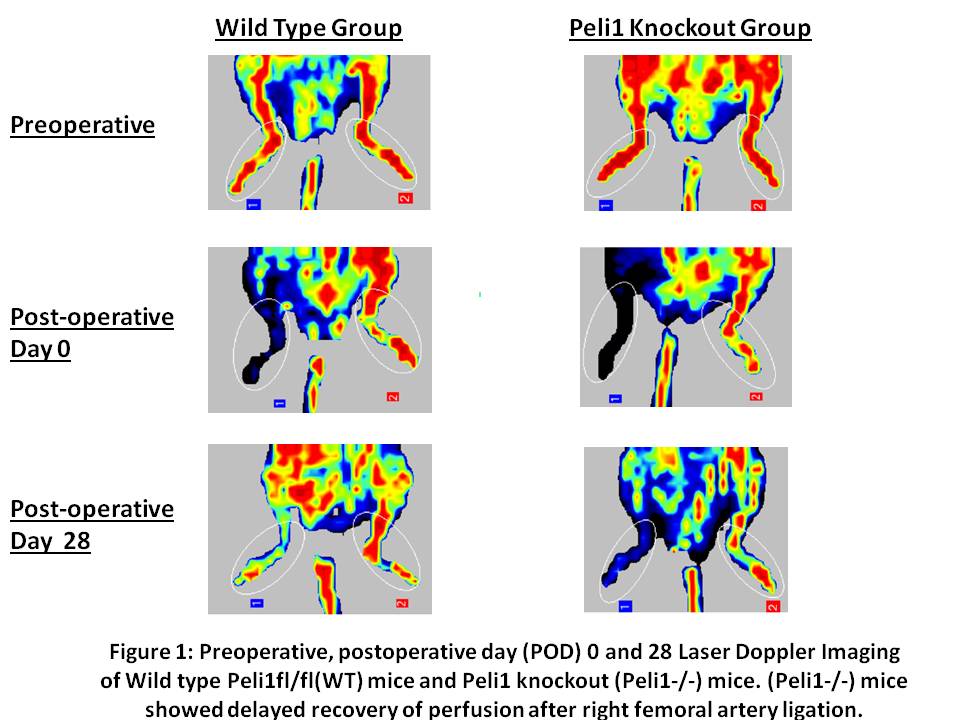Back to 2015 Annual Meeting
Silencing Novel Pro-angiogenic Molecule Pellino-1 (Peli1) Attenuates Ischemia Induced Neovascularization In A Murine Hind-Limb Ischemia Model
*Muhammad T Rishi1,2, *Inam A Shaikh1,2, *Vaithinathan Selvaraju2, David W McFadden2, J. Alexander Palesty1, *Nilanjana Maulik2
1Stanley J. Dudrick Department of Surgery, Saint Mary’s Hospital, Waterbury, CT;2Molecular Cardiology and Angiogenesis Laboratory, Department of Surgery, University of Connecticut Health, Farmington, CT
Objective:Our present study attempts to evaluate the role of Pellino-1 (Peli1), a novel pro-angiogenic molecule, in a murine model of hind limb ischemia(HLI).
Design:Preclinical Animal Study. Follow-up duration: 28 Days.
Setting:Molecular Cardiology and Angiogenesis Laboratory; University Research Facility
Patients:Four groups of following adult 8-12 week old mice:
1. Wild type Peli1fl/fl(WT) mice and Peli1 knockout (Peli1-/-) mice.
2. Ad.LacZ(control) or Ad.Peli(gene therapy) group.
Interventions:The WT and Peli1-/- mice underwent right femoral artery ligation followed by Laser Doppler Imaging (LDI), motor function assessment and muscle immunohistochemistry 28 days after ligation. We further validated our results in a gene therapy model (gain of function) by injecting either Ad.LacZ (control) or Ad.Peli1 (1x109 PFU) in the hind-limb after femoral artery ligation followed by LDI.
Main Outcome Measures:Silencing of pro-angiogenic molecule Pellino-1 (Peli1) attenuates ischemia-induced neovascularization in a murine hind-limb ischemia model.
Results:Peli1-/- mice showed reduced blood perfusion when compared to WT mice at post-operative day 28 [0.34±0.03 vs. 0.67±0.06 (n=15-16);p<0.05][Figure 1], decreased motor function score [2.0±0.44 vs. 3.98±0.02 (n=5);p<0.05], increased fibrosis [13.17±1.51 vs. 2.15±0.47(n=4-7);p<0.05], reduced capillary/vessel density [750.0 ± 69.96 vs. 1690±126 counts/mm²(n=4-6);p<0.05) and reduced capillary/myocyte ratio [1.44±0.11 vs. 2.093±0.23(n=4);p<0.05]. With Ad.Peli1 gene treatment, we observed a significant recovery of blood perfusion when compared to Ad.LacZ mice at post-operative day 28 [0.58±0.04 vs. 0.20±0.02(n=10-11);p<0.05].
Conclusions:Our results show that Peli1 is a critical molecule in neovascularization in mice with hind limb ischemia. This can translate to a powerful therapeutic agent assisting vascular surgeons in treating patients at risk for tissue and limb loss.

Back to 2015 Annual Meeting
|
|
